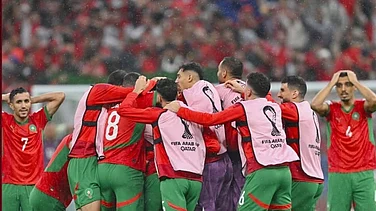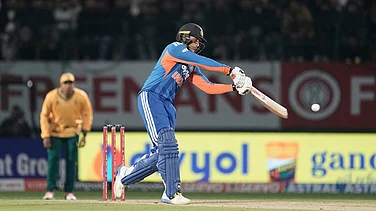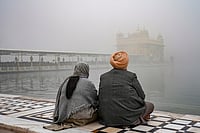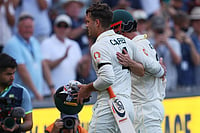In the cult Hollywood classic Escape to Victory, the legendary, diminutive Pele, part of the Allied POW team, takes on the Germans—tall and massively built—with his sheer talent and speed. Watching the first game of the FIFA Under-17 World Cup between India and the US in Delhi recently was a bit like that. Though, as in the movie, there was no fairy tale ending, there was enough drama. The Indian boys, puny against their muscular opponents, particularly so while tackling the aerial ball, surprised everyone with their gutsy show. India lost 0-3, but few could have predicted the stomach for the fight they put up.
As India made its World Cup debut, the home-grown colts locked horns fiercely with their more experienced opponents, surprising rival coaches. Amarjit Singh Kiyam’s team was vociferously supported by the packed galleries of the floodlit Jawaharlal Nehru Stadium in New Delhi, where all three India matches were played. Each attempt at the rival goal or a save by the brilliant Dheeraj Singh Moirangthem was greeted with full throttle roars of “Indiaaa...Indiaaa” and, at times, by chanting names of players. Often, tens of thousands of spectators would switch their mobile torches on in appreciation. Feverish expectation charged the air.
Although India lost all three group matches, the tall Manipur midfielder Jeakson Singh Thounaojam (see interview) made history by scoring the first Indian goal at the World Cup—the only one. He scored against Colombia off a well-executed header off a perfect corner kick from defender Sanjeev Stalin, triggering untramelled joy on the ground and in the galleries. With the unparalleled taste of a World Cup in their hearts and feet, can this be a turning point in Indian football? Can this World Cup, though for juniors, spark a new interest in the game, and rebuild our once intense football culture? Can India at least hope to recapture its lost glory as a major Asian football team? Despite the defeats, almost all Indian players were focussed and never looked demoralised, always gutsily chasing the ball.
Though India got to play the Cup by virtue of being the hosts, everyone is impressed with their performance. “The Indian team played beyond my expectation. They fought hard and were competitive, though the gap between them and their opponents showed. After all, they played against three established teams—Ghana, Colombia and the US,” says Shaji Prabhakaran, former AIFF director of National Teams and Youth Development. There was more good football news. The senior national team booked a ticket to the AFC Asian Cup, in the UAE next year with a 4-1 win against Macau in a qualifying match in Bangalore on October 11. The feat prompted chief national coach Stephen Constantine to dub the Sunil Chhetri-led team “one of the best Indian teams in history”.

Under-17 player Jeakson Thounaojam heads in India’s first World Cup goal against Colombia
That might prompt old-timers into lip-curling smiles. The senior Indian team is not even a force at the Asian level. Currently ranked 105th, India’s average position since the creation of FIFA’s world ranking is a dismal 133 among 200-plus nations. The country has never played a senior World Cup and hasn’t qualified for the Olympics in the last 57 years; its last appearance was in 1960. India made it to the 1950 World Cup in Brazil by sheer default, when several Asian countries withdrew after qualifying. But India missed even that. When the All India Football Federation (AIFF), received FIFA’s invitation for participation, the story goes that it failed to generate funds to meet the travel cost, forcing the team to withdraw. AIFF mandarins simply failed to appreciate the enormity of the honour. The popular myth, of course, is that Indian players wanted to play barefoot, which the FIFA had already banned, and that’s why the team pulled out. However, then India captain Sailen Manna contests this. (The Indians had played without boots at the London Olympics in 1948, their Olympic debut).
After the ignominy of losing 1-10 to Yugoslavia at the 1952 Olympics (the barefoot footballers were frozen out in the cold Helsinki weather), India’s game were a revelation at the 1956 Games in Melbourne. Coached by the legendary Syed Abdur Rahim, the team finished an amazing fourth—its best Olympic performance till date. In Melbourne, India beat hosts Australia 4-2, thanks to a hat-trick by Neville Stephen D’Souza—the first Asian to achieve the feat at the Olympics—as the team became the first Asian country to reach the semis. The Samar ‘Badru’ Banerjee-led India went down 1-4 to Yugoslavia in the semis after having led 1-0, and eventually lost 0-3 to Bulgaria in the bronze medal play-off. The team had stalwarts like Peter Thangaraj, S.K. Azizuddin, Noor Mohammed, P.K. Banerjee, ‘Kesto’ Pal, the mighty Tulsidas Balaram, and M. Zulfiqaruddin.
Indeed, the national team rode high between 1948 and 1964—Indian football’s ‘Golden Era’—during which the redoubtable ‘Rahim saab’ was the national coach. India, then the Asian powerhouse, reached the quarters of the 1948 Olympics, where they wasted two penalties against France and lost 1-2, and won gold at the Delhi Asiad in 1951. Besides, India was fourth at the 1958 Asian Games in Tokyo, clinched an Asiad gold in Jakarta in 1962, and finished second at the 1964 Asian Cup.
Yet Rome—India’s soccer prowess in this case—wasn’t built in a day. In Goa, Kerala, Hyderabad and Bengal there existed an eco-system suffused with football culture that left few untouched. The fanatical followings of clubs like East Bengal and Mohun Bagan aside, there were fiercely fought, and obsessively watched, tournaments in practically every second mohalla and city—breeding grounds of future champions of the maidan. In Calcutta, families were split over club loyalty, friendships hinged on it, even matrimonial matches made on its basis. Songs, poems and movies celebrated its complete hold over the masses. Moreover, in pre-television days, enthusiasts like coach Amal Dutta would travel around and arrange for international matches to be shown through 16mm projectors to ‘educate’ people. Moreover, fans wouldn’t just watch football on TV; when a ‘big match’ ticket was treated like gold, galleries heaved with raw emotion.

Chennayin FC’s Davide Succi heads a ball in the penalty box of Atletico de Kolkata
With the death of Rahim in 1963 and notwithstanding some flashes of brilliance in later years, Indian football went down a spiral. The AIFF tried to revive football, like the launch of the Nehru Cup in 1982, in which initially quality international teams competed. Discontinued in 1997 due to lack of sponsors, it was revived in 2007 but died a natural death in 2012. India won the title in 2007, 2009 and 2012.
Why did India lose its football mojo? A major force in Asia for about two decades, how could it slump to such depths? And why did a phenomenally popular sport in many parts of India, especially Punjab, Bengal and the south, completely give way to cricket? One main reason, says former India captain Bhaichung Bhutia, is that the AIFF did not adapt itself to changes in football. “Till 1962, everybody was playing football, but not many countries, including the big ones, were so organised. They played with passion and love, as did India. Over the years, football changed in structure and in other aspects. India didn’t change with the times,” he says. Planning, a cruccial aspect in sport, had been missing. “We have the talent, but we don’t utilise it.... It is difficult to achieve anything without planning,” says 68-year-old Olympian Mohammed Habib, a former India captain and national coach who played in 1960s and 1970s.
Olympian Syed Shahid Hakim, son of Rahim saheb who went on to become a FIFA referee, has seen the ‘Golden Era’, its subsequent downfall, and is involved with FIFA Under-17 World Cup. Lack of tournaments and disappearing grounds due to urbanisation, he says, are the main reasons for Indian football’s sorry fate. “Jawaharlal Nehru once said that ‘trained manpower counts in the nation more than anything, more than gold, silver and money’. Football is also a technical subject. But administrators now are unaware of it as they haven’t played football. Club culture has gone down, football grounds are disappearing, there are hardly any inter-school competitions, and no football nurseries. Where will the players come from?” asks Hakim. AIFF general-secretary Kushal Das partially concurs. He admits the lack of structured grassroots and youth development programmes as reasons for the failure. “Lack of playing infrastructure is also one reason. It was difficult to find a reasonable playing surface for competitions,” says Das.
Among other reasons for the decline, lack of funds—and the ungainly shabbiness it engenders—tops the list. When there are no incentives for players and clubs are in dire straits, parents don’t encourage children to take up football. Controversies around administrators and team selections haven’t helped either. The great Chuni Goswami, captain of the gold-winning team at the 1962 Asiad, is bitter about the downfall. “The AIFF thought that the 1962 Asian Games gold was enough. They didn’t follow it up much after that. But football is not a static game; it’s a dynamic one. Every day it’s changing as far as standard is concerned; everybody is trying hard to keep the standard high,” Goswami, also Bengal’s former Ranji skipper, tells Outlook. He says AIFF did not organise foreign tours or invite teams to provide exposure to players. Much later, he points out, the federation realised its mistake. Sukhwinder Singh, a former India player and ex-national coach, also blames the federation. “We couldn’t compete with the speed at which the world football has changed, be it infrastructure, scientific inputs into the game, coaching, administration, or refereeing. If cricket has become India’s most popular sport, it is due to its administrative qualities. We cannot blame cricket for football’s downfall,” he says.
Past AIFF bosses have scored many own-goals. Often, national coaches were treated badly, allowed little time to gel with players and replaced after short stints. Few could settle down and chalk a proper roadmap for the national team. Syed Nayeemuddin captained India to bronze medal at the 1970 Asian Games. But, as a coach, AIFF didn’t listen to his requests for foreign exposure to the national team, and gave him two very short stints—1997-98 and 2005-06. “We didn’t provide guidance to promising youngsters. Why can’t boys do what their seniors have done? It’s because we did not provide them anything. For instance, Indian coaches were not respected, while foreign coaches were given good facilities and would tour abroad with teams,” says Nayeem. Bhutia, too, blames successive AIFF dispensations. “We kept producing class players, but not much was done. It’s not only about spending money, but about structure. South American countries, economically and infrastructure-wise, are the same, but their football structure is big—youth-level programmes, tournaments, matches—it’s quite a lot,” he says. In South America, kids aged eight or ten train and play at least 40 local matches a year, from where talent is spotted and nurtured, he informs.

Samar Banerjee, captain of India’s 1956 Melbourne Olympic team
The AIFF has still failed to put in a robust national tournament structure to the satisfaction of all. Now, I-League, the new avatar of the National Football League and launched in 2007-08, and the Indian Super League (ISL), the so-called professional competition started in 2014, have pushed the premier Santosh Trophy and Rovers Cup, bearers of talent for over 70 years, to the background. At present, a debate is raging if the I-League and ISL should be merged. “In the longer run, it is very, very important to have one combined national league with 14 to 16 teams and a second division with 14 to 16 teams, with relegation-promotion rule,” emphasises Bhutia. Portuguese Hugo Martins, an assistant coach of the current Indian under-17 team, says constantly providing competitive matches to players is crucial. “Young players in India arrive for professional football with less participation in competitive leagues. We cannot recreate in training the competitive experience,” Martins tells Outlook.
The first step to resurrect India’s footballing fortunes, therefore, is to organise leagues that would provide rich experience. One key issue is that India has been unable to produce many fearless, penetrative and productive strikers, though Ahmed Khan, Inder Singh, P.K. Banerjee, Balaram, Shyam Thapa, Magan Singh, Mohammed Habib, I.M. Vijayan and now Sunil Chhetri have excelled in different periods. Overall, quality of players has declined for all positions. To add to the woes, both I-League and ISL teams prefer having foreigners, particularly from Africa, as strikers rather than Indians, thus denying opportunity to local talent. “If you have good Indian strikers everybody would want to have them because they would save money. And to produce them we will have to start working...from the ground level. That’s not happening because there’s no structure,” says Bhutia.
For old-timers like Samar Banerjee, players today just don’t have the fire in them. The 87-year-old former forward suggests a simple solution. “Practice, practice, practice and hard work—that is the mantra. Not just for a day, a week, a month, or a year, but do these things year after year, only then do you get success. Where is that happening today? Where is the sincerity, honesty, loyalty? Money, wealth, and luxury have no role to play on the field,” Banerjee tells Outlook from Calcutta. Are we also at a disadvantage when it comes to our genetic make-up? Almost all players of the Indian Under-17 team at the World Cup were much smaller than their opponents. Is there a natural physical inferiority we have to contend with? No, says sports and performance psychologist Shree Advani, who feels height makes little difference in football. “Chinese are known to be short. So are Koreans. Lionel Messi too is pretty short, but he is a legend. We can’t have a blanket rule vis-a-vis genetics. Genetically shorter players can’t necessarily be inferior, though they can be psychologically weaker,” says Advani. Even Chhetri and Bhutia are not tall, he points out. Argentina’s Messi is just 5.5 ft tall while the great Pele was 5.6 ft. Even the talismanic genius Diego Maradona was only 5.4 ft, but could tie the best of defences in knots. If each of these dynamos could have blasted the opposition single-handedly, Indians can take inspiration from them.
AIFF’s Kushal Das admits that past amateurish dispensations, both at the federation and the state bodies, grievously harmed Indian football. “The lack of administration and technical skills amongst administrators in many states is also a reason. Even AIFF headquarters, the ‘Football House’, was built in 2004 in Delhi. Before that, the office used to be based where the elected general secretary was from. There was hardly any skilled staff in the AIFF,” he points out. He claims AIFF is now trying to organise itself and become professional. It started the under-18 national league a few years ago, under-15 two years ago and plans to start an under-13 national league. The next step is to start ‘baby leagues’ in the 6-12-year age-group across the country with help of the state associations. It will continue with chief coach Luis Norton de Matos, along with assistant coaches Hugo Martins and Floyd Pinto for under-17 team for the Under-19 AFC Qualifiers in Saudi Arabia, starting October 31. If India qualify for the 2018 AFC Championship, the AIFF will plan international competitions and exposure tours commencing immediately after the I-League, promises Das. “Our dream target for this team is to qualify for the Under-20 FIFA World Cup in 2019,” he says.
To achieve that, the most important factor will be not to lose the momentum of the under-17 World Cup. Hugo Martins says the players are more prepared now for the tough challenges ahead. “To give expression to the rich experience of the World Cup, there must be a future for these players. They demonstrated a good fighting capacity. However, their process is just beginning,” he says. India’s Under-17 footballers have shown a certain indomitable spirit. Now is the time for all stakeholders to come together with a blueprint, letting go of their egos and petty enmities. The India team will not be there in the final of this World Cup on October 28 in Calcutta. But Indian fans will be there. Now is the time to give them more football. Treetops and bleachers, once bristling with partisan pride and anger, are ready to bear the weight of a new generation of Indians soaked in the euphoria that only the beautiful game can provide.






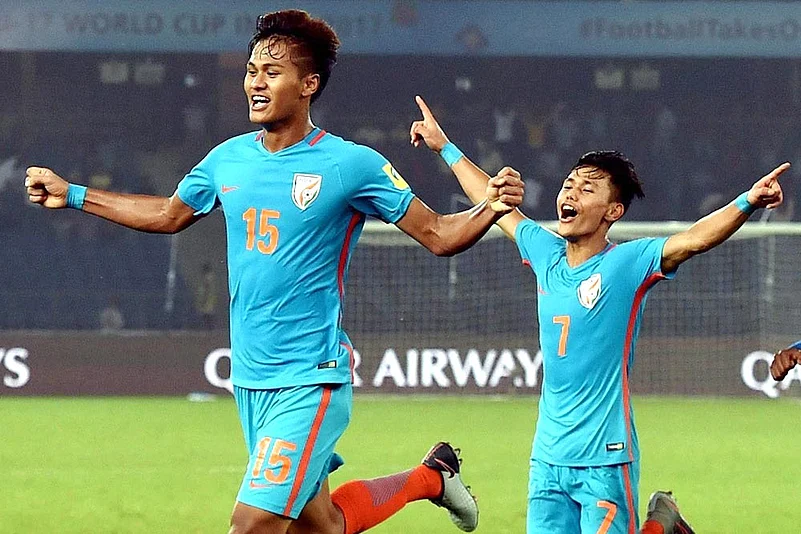
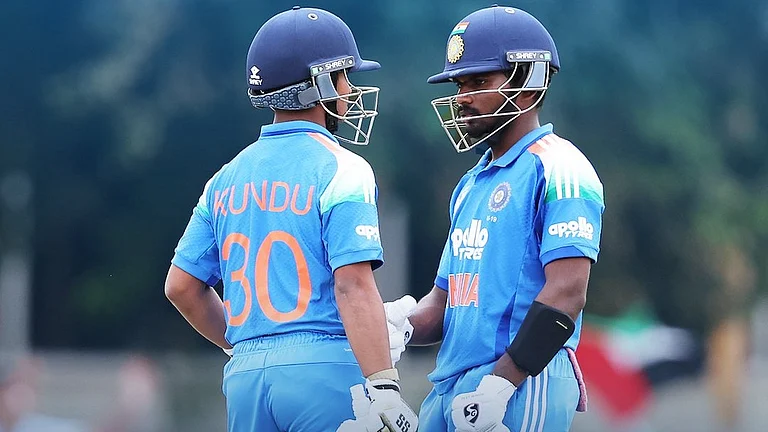
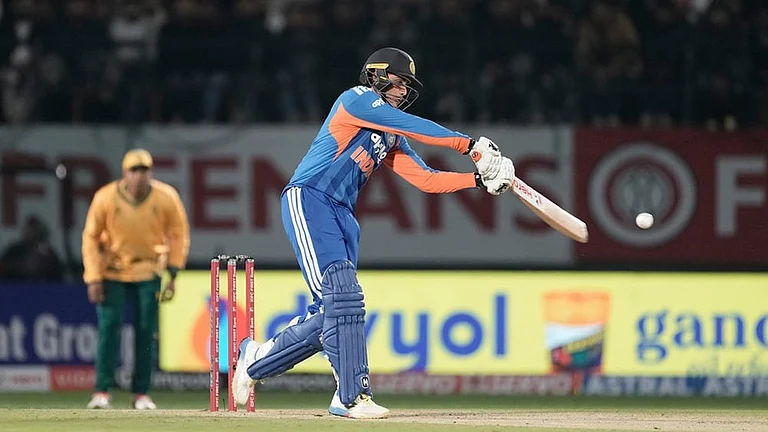

_.jpg?auto=format%2Ccompress&fit=max&format=webp&w=768&dpr=1.0)

